Democritus (460–370 BCE):
- The world is made up of
- atoms: collide with one another
- sensations: caused by these make contact with our sense organs
Sensory transducer:
A receptor that converts physical energy from the environment into neural energy
Sensation
- The ability to detect a stimulus + to turn that detection into a private experience.
- the result of the physical interaction between the world and our bodies
Perception
- The act of giving meaning to a detected sensation
- the processing and interpretation of sensations
Signal detection theory:
a psychophysical theory that quantifies the response of an observer to the presentation of a signal in the presence of noise
Monism
The idea that the mind and matter are formed from, or reducible to, a single ultimate substance or principle of being
Materialism
- The idea that physical matter is the only reality,
- everything including the mind can be explained in terms of matter and physical phenomena.
Mentalism:
- Another form of monism
- The idea that the mind is the true reality
- objects exist only as aspects of the mind’s awareness
Mind–body dualism:
- Originated by Descartes
- the idea positing the
existence of two distinct principles of
being in the universe- spirit/soul and matter/body
Perception and your sense of reality are the products of
evolution
- Sensory systems provide a survival advantage
- Importance of type of energy in the environment
for an animal determines which senses have
developed - Human
senses are limited to only certain kinds of
energy in the environment- Therefore, humans’ sense of reality is also limited
Adaptation:
- A reduction in response caused by
prior or continuing stimulation - No change in stimulation = our senses
adapt- we no longer notice the stimulation
Nativism:
- the mind produces ideas that are not derived from external sources
- we have abilities that are innate and not learned
Dualism:
both mind and body exist and are separate entities
René Descartes (1596– 1650)
- argued for mind-body dualism,
- the universe consists of spirit/soul and matter/body
Empiricism
- All knowledge comes through the senses
(perception)
- Opposed to
nativism, which says that some
knowledge is innate
- Opposed to
nativism, which says that some
Thomas Hobbes (1588–1678)
- believed that everything that could ever be known or imagined had to be learned through the senses
John Locke (1632–1704)
- aim to explain how all thoughts, even complex ones, could be constructed from EXPERIENCE with a collection of sensations
George Berkeley (1685–1753)
- studied ways in which perception is limited to the
information available to us through our
eyes
- All of our knowledge about the world must come from experience, (no matter how limited perception may be)
Thresholds:
Finding the limits of what can be perceived.
Scaling:
Measuring private experience.
Signal detection theory:
Measuring difficult decisions.
Sensory neuroscience:
The biology of sensation and perception.
Neuroimaging:
An image of the mind
Development:
Change across the lifespan.
Gustav Fechner (1801–1887)
- invented “psychophysics”
- considered to be the true founder of experimental psychology
Psychophysics:
The science of defining quantitative relationships between physical and psychological (subjective) events
Dualism:
- The mind has an existence separate from the material world of the body.
Materialism:
- The only thing that exists is matter
- all things, including mind and consciousness = interactions between bits of matter.
Panpsychism:
- The mind exists as a property of all matter
- all matter has consciousness.
- all matter has consciousness.
Psychophysics adopted several new concepts for understanding sensation and perception.
- Two-point threshold
- Just noticeable difference (JND)
- Absolute threshold
Two-point threshold:
- the minimum distance at which two stimuli
(e.g., two
simultaneous touches) can be distinguished
Just noticeable difference (JND):
-
The smallest detectable difference between
two stimuli, or the minimum change in a
stimulus- that
can be correctly judged as
different from a reference stimulus - also known as difference threshold.
- that
can be correctly judged as
Absolute threshold:
-
The minimum amount of stimulation necessary for a
person to
detect a stimulus 50% of the time.
Ernst Weber (1795–1878)

-
“Weber’s Law”
- the smallest change in a stimulus (that can be detected) = a constant proportion of the stimulus level
-
As stimulus level increases or
decreases,-
the magnitude of change must increase
proportionately = remain
noticeable
-
the magnitude of change must increase
proportionately = remain
Fechner’s law:

- principle describing the relationship between
stimulus magnitude and resulting sensation magnitude- that the magnitude of subjective
sensation increases
proportionally to stimulus intensity (logarithm)
- that the magnitude of subjective
sensation increases
Method of constant stimuli
- many stimuli = rarely to always perceivable
- presented one at a time
- "I don't hear it." => "I hear it."
Method of limits:
- magnitude/difference btn 2 stimuli varied
incrementally
- until participant responds differently
Magnitude estimation:
- The participant assigns values according to the perceived magnitudes of the stimuli
- S = al^b
Cross-modality matching:
The participant matches the
intensity of a sensation in one sensory modality
with
the intensity of a sensation in another
Signal detection theory:
- A psychophysical theory that
quantifies the response of an observer to the presentation
of a signal in the presence of noise
Four possible stimulus/response situations
- Hit
- Miss
- False Alarm
- Correct Junction
Four possible stimulus/response situations: HIT
- Stimulus is presented
- observer responds “Yes”
Four possible stimulus/response situations: MISS
- Stimulus is presented
- observer responds “No”
Four possible stimulus/response situations: FALSE ALARM
- Stimulus is not presented
- observer responds “Yes”
Four possible stimulus/response situations: CORRECT REJECTION
- Stimulus is not presented
- observer responds “No”
Receiver operating characteristic:
- In studies of signal detection,
- the graphical plot of the hit rate as a function of the false alarm rate
Stevens’ power law:

- A principle describing the
relationship between stimulus magnitude + resulting
sensation magnitude - the
magnitude of
subjective sensation = proportional to the stimulus
magnitude raised to an exponent
Cranial nerves:
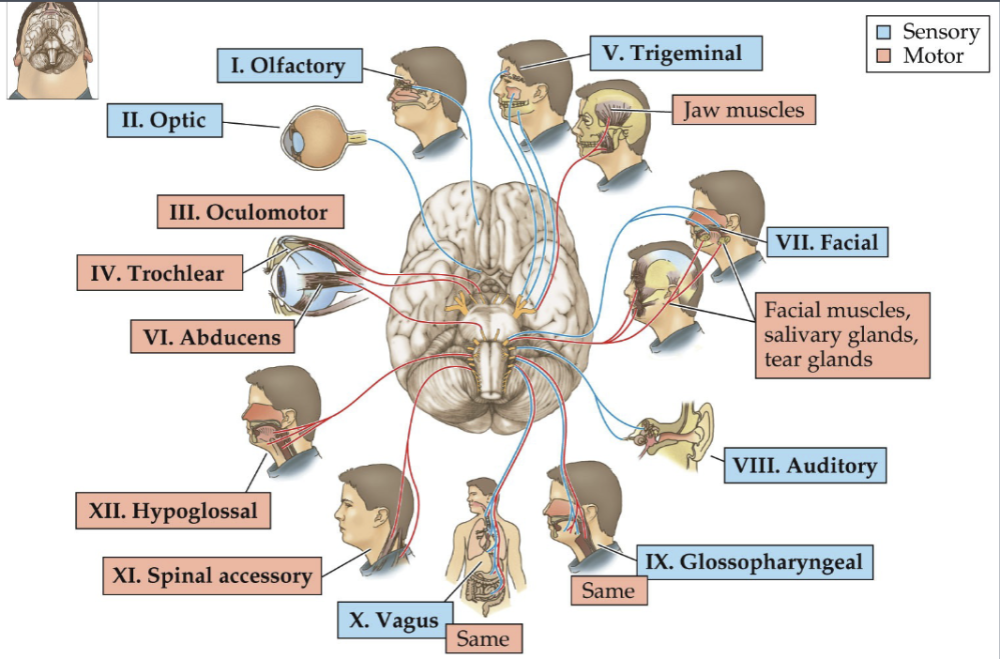
- Twelve pairs of nerves (one for each side of the body) that originate in the brain stem
- reach sense organs and muscles
through openings in the
skull
Sensory information nerves
- Olfactory (I) nerves
- Optic (II) nerves
- Auditory (VIII) nerves
Muscles that move the eyes nerves
- Oculomotor (III)
- Trochlear (IV) nerves
- Abducens (VI) nerves
Hermann von Helmholtz (1821–1894)
- First person to measure the speed of neural impulses
- Invented the ophthalmoscope
- Wrote On the Sensations of
Tone (1863)
- one of the first studies of auditory perception
Santiago Ramón y Cajal (1852–1934)
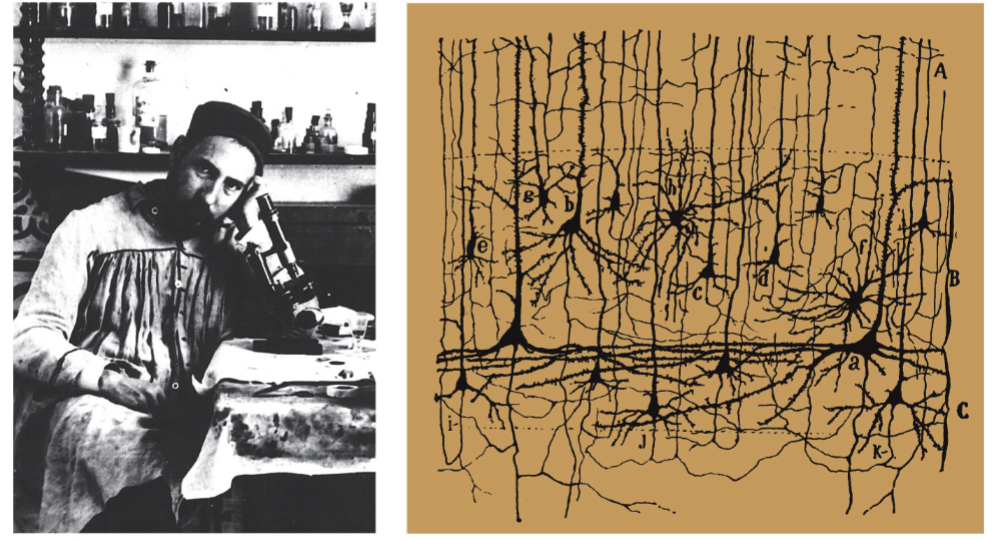
- Created incredibly detailed drawings of neurons and neural structure
Synapse:
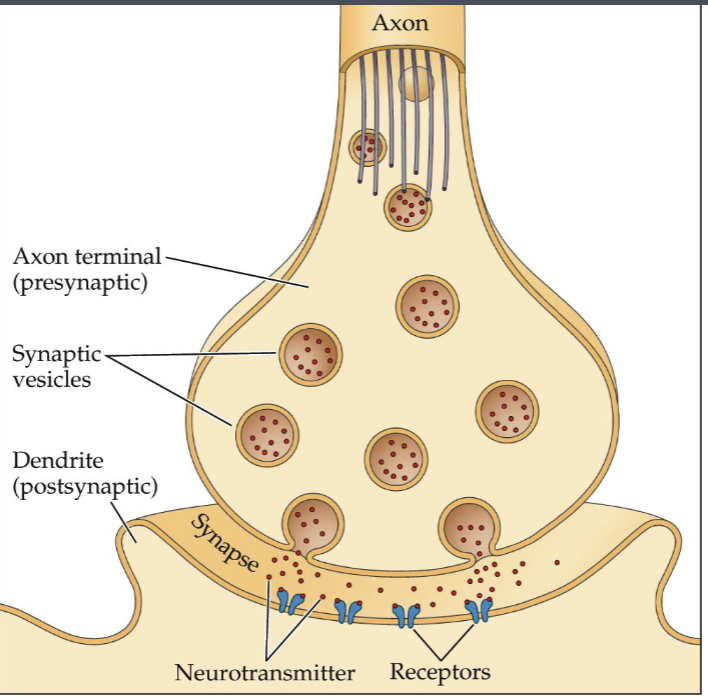
The junction between neurons that permits information transfer
Neurotransmitter:
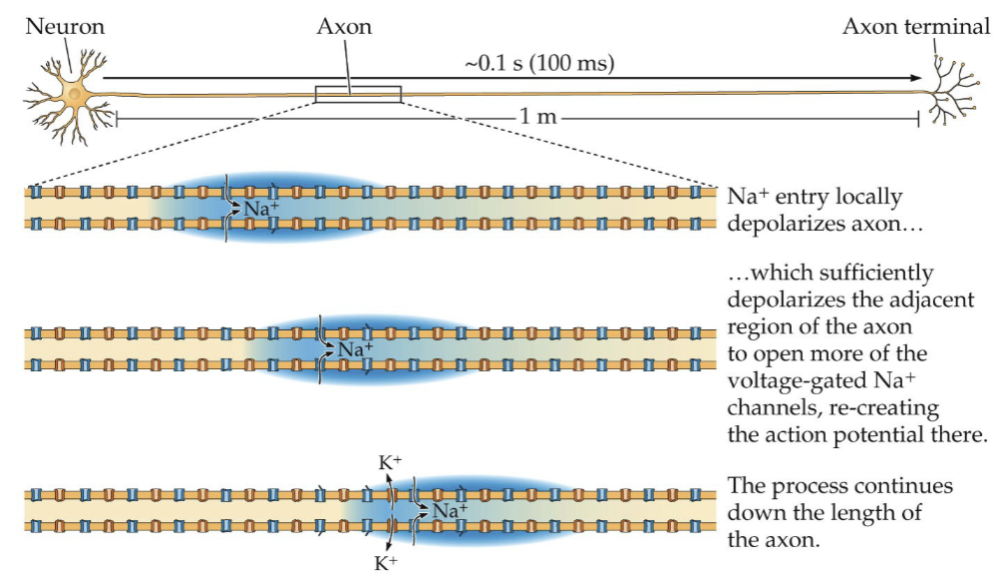
A chemical substance used in
neuronal
communication at synapses
Detection types
- method of constant stimuli
- method of limits
- SDT
- adaptive testing
Discrimination
- weber's law
- choice response time
Scaling
- fechner's law (indirect)
- Stevens' Law (direct)
Indentification
- information theory
- channel capacity
- identification time
two point threshold
the minimum distance at which 2 stimuli can be distinguished
reciever operating characteristic (ROC)
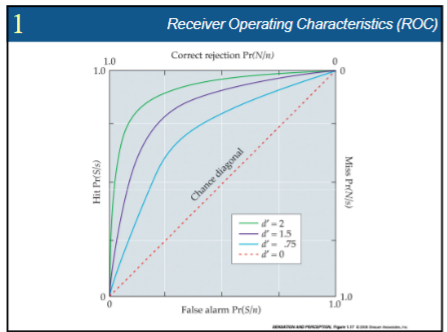
- in studies of signal detection
- the graphical plot of the hit rate as a function of the false alarm rate
- good performance (high sensitivity) "bows out" towards upper left corner
Sensitivity
- a values that defines the ease with which an observer can tell
the difference between the presence
and absence of a stimulus
- difference between stimulus 1 and stimulus 2
Criterion
- an internal threshold that is set by the observer
- internal response above criterion => observer gives 1 response
- below criterion => observer gives another response
Doctrine of specific nerve energies
- Johannes Muller
- nature of a sensation depends on
what sensory fibers are stimulated
- not how fibers are stimulated
- auditory nerves = auditory info